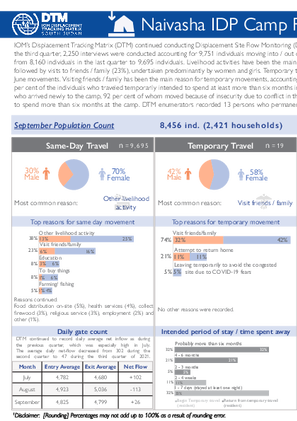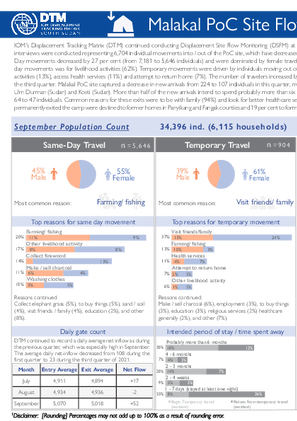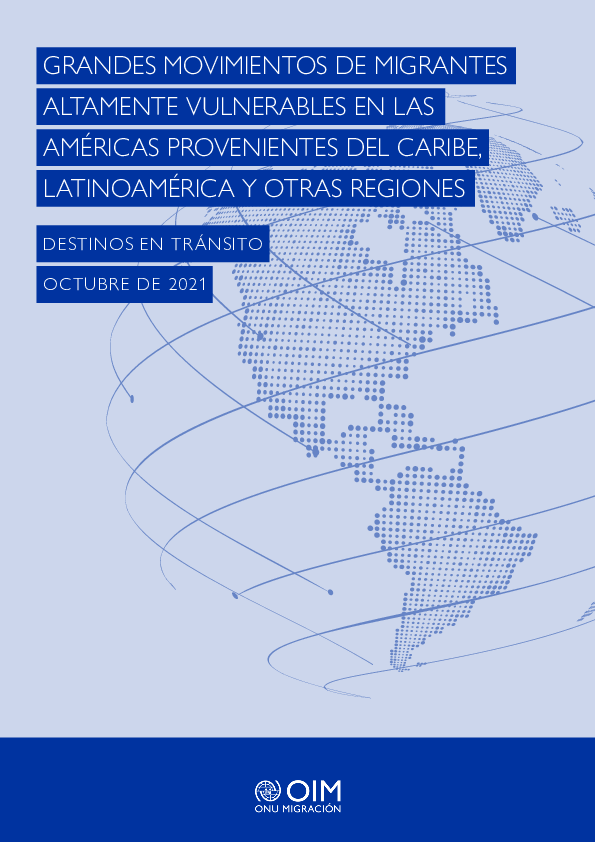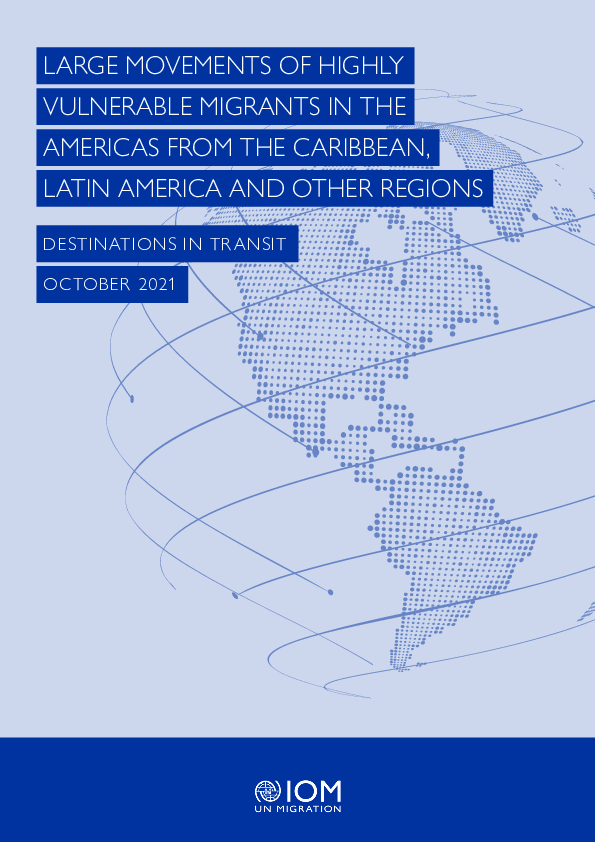-
Countries
-
Data and Analysis
-
Special Focus
-
Crisis Responses

Contact
DTM South Sudan, SouthSudanDTM@iom.int
Language
English
Location
South Sudan
Period Covered
Jul 01 2021
Sep 30 2021
Activity
- Flow Monitoring
IOM’s Displacement Tracking Matrix (DTM) continued conducting Displacement Site Flow Monitoring (DSFM) at the gates of Naivasha IDP Camp. During the third quarter, 2,250 interviews were conducted accounting for 9,751 individuals moving into / out of the camp. Recorded day movements increased from 8,160 individuals in the last quarter to 9,695 individuals. Livelihood activities have been the main drivers for the increased day movements (38%), followed by visits to friends / family (23%), undertaken predominantly by women and girls. Temporary travels decreased by 5 per cent, relative to April – June movements. Visiting friends / family has been the main reason for temporary movements, accounting for 74 per cent of temporary travels. Thirty-two per cent of the individuals who traveled temporarily intended to spend at least more than six months in / out of the camp. DTM surveyed 24 individuals who arrived newly to the camp, 92 per cent of whom moved because of insecurity due to conflict in their areas of departure. All the new arrivals intend to spend more than six months at the camp. DTM enumerators recorded 13 persons who permanently left the camp with all exits destined to Wau.
Contact
DTMAfghanistan@iom.int
Location
Afghanistan
Activity
- Site Assessment
- Mobility Tracking
Period Covered
Apr 01 2021 -Jun 30 2021
A Community-Based Needs Assessment (CBNA), intended as an integral component of DTM's Baseline Mobility Assessment to provide a more comprehensive view of multi-sectoral needs in settlements hosting IDPs and returnees.
Population Groups
Survey Methodology
Unit of Analysis Or Observation
Type of Survey or Assessment
Keywords
Geographical Scope
Administrative boundaries with available data
The current dataset covers the following administrative boundaries

Contact
DTM South Sudan, SouthSudanDTM@iom.int
Language
English
Location
South Sudan
Period Covered
Jul 01 2021
Sep 30 2021
Activity
- Flow Monitoring
IOM’s Displacement Tracking Matrix (DTM) continued conducting Displacement Site Flow Monitoring (DSFM) at the gates of Malakal PoC Site. During this period, 3,135 interviews were conducted representing 6,704 individual movements into / out of the PoC site, which have decreased compared to 8,280 movements in the previous quarter. Day movements decreased by 27 per cent (from 7,181 to 5,646 individuals) and were dominated by female travelers (55%). Among all respondents, the main reason for day movements was for livelihood activities (62%). Temporary movements were driven by individuals moving out of the site to visit friends / family (37%), tend to livelihood activities (13%), access health services (11%) and attempt to return home (7%). The number of travelers increased by 10 per cent, from 811 in the previous quarter to 904 in the third quarter. Malakal PoC site captured a decrease in new arrivals from 224 to 107 individuals in this quarter, most of whom arrived from Panyikang, Fangak, Ayod, Juba, Um Durman (Sudan) and Kosti (Sudan). More than half of the new arrivals intend to spend probably more than six months in the site. Permanent exits also decreased from 64 to 47 individuals. Common reasons for these exits were to be with family (94%) and look for better healthcare services (6%). Seventy-four per cent of the individuals who permanently exited the camp were destined to former homes in Panyikang and Fangak counties and 19 per cent to former areas but new homes in Kosti and Um Durman (Sudan).

Contact
DTM South Sudan, SouthSudanDTM@iom.int
Language
English
Location
South Sudan
Period Covered
Jul 01 2021
Sep 30 2021
Activity
- Flow Monitoring
IOM’s Displacement Tracking Matrix (DTM) continued conducting Displacement Site Flow Monitoring (DSFM) at the gates of Wau Masna Collective Centre. In the third quarter of 2021, 2,462 interviews were conducted representing 4,248 individual movements in and out of the collective centre. Day movements saw a 26 per cent increase relative to the previous quarter. These movements were mainly driven by male travelers (62%), and the main reasons for travel were to tend to livelihood activities (29%) and to look for better health services (11%). Temporary movements saw a 12 per cent decrease compared to the previous quarter with the main reason being farming / fishing (48%). Ninty-three per cent of the individuals traveling temporarily intend to spend at least more than six months in / out of the collective centre. The third quarter recorded a significant decrease in new arrivals from 284 in the previous quarter to 7 individuals. Eighty-six per cent of the individuals who newly arrived in the collective centre moved because of hunger due to conflict, and 14 per cent due to insecurity related to conflict in their areas of departure. All individuals intend to spend more than six months at the centre. DTM did not encounter persons intending to permanently leave the collective centre this reporting period.

Contact
DTM South Sudan, SouthSudanDTM@iom.int
Language
English
Location
South Sudan
Period Covered
Jul 01 2021
Sep 30 2021
Activity
- Flow Monitoring
IOM’s Displacement Tracking Matrix (DTM) continued conducting Displacement Site Flow Monitoring (DSFM) at the gates of Bentiu IDP Camp. The third quarter (July – September) recorded 6,792 interviews accounting for 27,034 individuals moving into / out of the camp. Day movements increased this quarter by 8 per cent (from 9,332 to 10,106 individuals) and were dominated by women and girls (74%). Among all respondents, the main reason for day movements were to collect firewood (20%). Temporary movements were driven by individuals moving out of the camp to collect firewood (19%), visiting friends / family (18%) and attempting to return home (17%). The number of travelers has increased from 12,205 to 16,505 individuals (35% increase compared to the second quarter). Bentiu IDP Camp recorded a 27 per cent decrease in new arrivals most of whom arrived from Rubkona, Panyijar, Khartoum (Sudan) and Jabal Aulia (Sudan). Eighty-nine per cent of the new arrivals intend to spend more than six months in the camp. Permanent exits decreased drastically from 737 in the second quarter to 272 individuals during this quarter. Common reasons for these exits were to be with family (35%), to look for livelihood / work opportunities (16%), and due to improved living conditions at locations of destination (14%). Seventy-three per cent of the individuals who permanently exited the camp were destined to former homes in Rubkona and Guit counties.

Contact
DTMAfghanistan@iom.int
Language
English
Location
Afghanistan
Period Covered
Apr 01 2021
Jun 30 2021
Activity
- Site Assessment
- Mobility Tracking
In April through June 2021, DTM implemented the Community-Based Needs Assessment (CBNA) at the settlement level, as an integral component of DTM's Baseline Mobility Assessment (BMA), providing a comprehensive overview of the evolving, multi-sectoral needs in settlements hosting IDPs and returnees.

Contact
dtmcovid19@iom.int
Language
English
Location
Global
Period Covered
Mar 13 2020
Dec 16 2021
Activity
- Mobility Tracking
- Points of Entry (PoE)
IOM COVID-19 Impact on Points of Entry Bi-Weekly Analysis is meant to serve IOM Member States, IOM, UN and voluntary partner agencies, the civil society (including media) as well as the general population in analysing the impact of COVID-19 pandemic on Points of Entry. It is particularly relevant when identifying and addressing specific needs faced by migrants and mobile populations, disproportionately affected by global mobility restrictions. The report is based on information provided by IOM field staff, using resources available at the IOM country office level and is accurate to the best of IOM’s knowledge at the time of compilation. All information is being constantly validated, including the geolocation and attributes, and through regular assessments and triangulation of information. The updates depend on the time frame within which the information becomes available and is processed by IOM. For this reason, the analysis is always dated and timestamped in order to reflect reality at a given time. However, as the situation continuously evolves and changes, despite IOM’s best efforts, the analysis may not always accurately reflect the multiple and simultaneous restrictive measures being imposed at a specific location.

Contact
DTMAfghanistan@iom.int
Language
English
Location
Afghanistan
Period Covered
Apr 01 2021
Jun 30 2021
Activity
- Mobility Tracking
- Baseline Assessment
In Afghanistan, DTM employs the Baseline Mobility Assessment tool, designed to track mobility, determine the population sizes, locations and geographic distribution of forcibly displaced, return and migrant populations, reasons for displacement, places of origin, and times of displacement, as well as basic demographics, vulnerabilities and priority needs. Data is collected at the settlement level, through community focus group discussions with key informants and direct observations.
As of 30 June 2021, 34 provinces, 401 districts and 12,969 settlements have been assessed, including interviews with 76,464 key informants. Between 2012 and June 2021, 4,690,422 returnees and 5,333,654 IDPs currently living in host communities were identified.
La migración en América del Sur y Central ha visto importantes cambios en las últimas dos décadas. La migración intrarregional sigue siendo la más importante en América del Sur, sobre todo debido a los movimientos a gran escala de personas migrantes y refugiadas venezolanas en los últimos cinco años. Mientras tanto, la migración desde América Central ha aumentado significativamente en los últimos años. Además, las nacionalidades de las personas migrantes se han diversificado en gran medida, incluyendo a nacionales de países del Caribe y de otros continentes como Asia y África.Este informe busca dar cuenta de la magnitud, evolución y trayectoria de dichos movimientos en los últimos años. Esta situación no es un cambio repentino si no que se funda en un conjunto de factores y una diversidad de migrantes, medidas y cambios socioeconómicos, sanitarios y políticos recientes en países de destino anteriores en América del Sur como en los países de origen y tránsito de esta población migrante. La comprensión de esos factores habilita a un análisis pertinente para el desarrollo de políticas y medidas públicas que puedan asegurar una migración ordenada, segura y regular protegiendo los derechos humanos de las personas migrantes.
Migration in South and Central America has undergone significant changes in the last two decades. Intraregional migration continues to be the most important in South America, mainly due to the large-scale movements of Venezuelan migrants and refugees in the last five years. Meanwhile, migration from Central America has increased significantly in recent years. In addition, the range of nationalities of migrants has become more diverse, and includes nationals from Caribbean countries and from other continents such as Asia and Africa. This report seeks to account for the size, evolution and routes of these movements from other regions in recent years. It is not a sudden movement but is based on a set of factors and a diversity of migrants, and also on recent socio-economic, health and political changes and measures in their previous countries of destination in South America, as well as in the countries of origin and transit of this migrant population. Understanding these factors allows a proper analysis to be carried out for developing public policies and measures that can ensure orderly, safe and regular migration while protecting the human rights of migrants.


